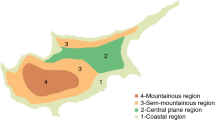Abstract
Climate change is expected to influence the cooling energy demand of residential buildings and affect overall thermal comfort. Cooling degree day (CDD) requirements are among the most important human issues in the fields of agriculture, tourism, and energy management in the present and future. Knowing the extent of these changes can be very effective in managers’ decision-making. The present study aims to investigate changes in cooling requirements under climate change conditions in South Khorasan Province. To this end, daily maximum and minimum temperature data of 11 synoptic stations in South Khorasan Province were obtained from the Iran Meteorological Organization (IRIMO) during the period 1994–2019. The available scenarios of the fifth report of the Climate Change Intergroup (AR5 2014) include RCP scenarios from the Canadian Climate Change Web site, and the data for the upcoming period (2020–2046) in the study area was downscaled using the SDSM software. The monthly and annual cooling requirements of the sites were calculated in the observation and upcoming period via MATLAB software for warm months (May–September). The temperature threshed of 23 degrees centigrade was applied for the calculation of CDD requirements. Finally, using the Kriging interpolation method, the zoning maps of cooling requirements for present and upcoming periods were drawn via ArcGIS software. Investigating the effect of geographical coordinates (latitudes, longitudes, and elevations of stations) on cooling requirements in the region, it was determined that the role of elevation is very effective on the spatial variation of cooling requirements. In warm months, low-lying areas (Khur, Boshruyeh, and Tabas) require higher energy levels due to the need for more cooling. The increase in the temperature and warm weather in spring, especially in May and June in most places, requires further use of cooling systems in the future.







Similar content being viewed by others
References
Andrade C, Contente J (2020) Climate change projections for the worldwide bioclimatic classification system in the Iberian peninsula until 2070. Int J Climatol 40(14):5863–5886. https://doi.org/10.1002/joc.6553
Artmann N, Gyalistras D, ManzHeiselberg HP (2008) Impact of climate warming on passive night cooling potential. Build Res Inf 36(2):111–128. https://doi.org/10.1080/09613210701621919
Bonsal BR, Zhang X, Vincent LA, Hogg WD (2001) Characteristics of daily and extreme temperatures over Canada. J Clim 14(9):1959–1976. https://doi.org/10.1175/1520-0442(2001)014%3c1959:CODAET%3e2.0.CO;2
Chen L, Fang XQ, Li S (2007) Impacts of climate warming on heating energy consumption and southern boundaries of severe cold and cold regions in China. Chin Sci Bull 52(20):2854–2858. https://doi.org/10.1007/s11434-007-0386-7
Corrales-Suastegui A, Ruiz-Alvarez O, Torres-Alavez JA, Pavia EG (2021) Analysis of cooling and heating degree days over Mexico in present and future climate. Atmosphere 12(9):1131. https://doi.org/10.3390/atmos12091131
Cox RA, Drews M, Rode C, Nielsen SB (2015) Simple future weather files for estimating heating and cooling demand. Build Environ 83:104–114
Crawley DB (1994) Development of degree Day and degree hour data for international locations. DB Crawley Consulting, Washington DC
Hitchin ER (1981) Degree-days in Britain. Build Serv Eng Res Technol 2:73–82
Imanipour H (2018) Analysis of the heating and cooling degree day requirements changes under climate changes in Southern Khorasan Province. MSc Thesis, Hakim Sabzevary University.
Jiang F, Li X, Wei B, Hu R, Li Z (2009) Observed trends of heating and cooling degree-days in Xinjiang Province. China Theor Appl Climatol 97(3):349–360. https://doi.org/10.1007/s00704-008-0078-5
Kadioglu M, Sen Z, Gultekin L (1999) Spatial heating monthly degree-day features and climatologic patterns in Turkey. Theoret Appl Climatol 64(3):263–269. https://doi.org/10.1007/s007040050128
Kassambara A (2018). Machine learning essentials: practical guide in R sthda.
Quayle RG, Diaz HF (1980) Heating degree day data applied to residential heating energy consumption. J Appl Meteor 19:241–246
Ramon D, Allacker K, De Troyer F, Wouters H, van Lipzig NP (2020) Future heating and cooling degree days for Belgium under a high-end climate change scenario. Energy Build 216:109935
Rehman S, Al-Hadhrami LM, Khan S (2011) Annual and seasonal trends of cooling, heating, and industrial degree-days in coastal regions of Saudi Arabia. Theoret Appl Climatol 104(3):479–488. https://doi.org/10.1007/s00704-010-0359-7
Said SAM (1992) Degree-day base temperature for residential building energy prediction in Saudi Arabia. In ASHRAE Winter Meeting, Anaheim, CA, USA, 01/25–29/92 (pp:346–353)
Schaeffer R, Szklo AS, de Lucena AFP, Borba BSMC, Nogueira LPP, Fleming FP, Boulahya MS (2010) Energy sector vulnerability to climate change: a review. Energy 38(1):1–12. https://doi.org/10.1016/j.energy.2011.11.056
Soule PT, Suckling PW (1995) Variations in heating and cooling degree-days in the south-eastern USA, 1960–1989. Int J Climatol 15(4):355–367. https://doi.org/10.1002/joc.3370150402
Spinoni J, Vogt JV, Barbosa P, Dosio A, McCormick N, Bigano A, Füssel HM (2018) Changes in heating and cooling degree-days in Europe from 1981 to 2100. Int J Climatol 38:e191–e208. https://doi.org/10.1002/joc.5362
Thom HCS (1952) Seasonal degree-day statistics for the United States. Mon Weather Rev 80(9):143–147. https://doi.org/10.1175/1520-0493
Wibig J (2003) Heating degree days and cooling degree days variability in Lodz in the period 1931–2000. In Fifth International Conference on Urban Climate. Lodz, Poland (pp:471–474)
Author information
Authors and Affiliations
Contributions
All authors contributed to the study’s conception and design. Material preparation, data collection, and analysis were performed by Abdolreza Kashki, Mokhtar Karami, and Hossein Imanipour. Hossein Imanipour wrote the first draft of the manuscript, and all authors commented on previous versions of the manuscript. All authors read and approved the final manuscript.
Corresponding author
Ethics declarations
Consent for publication
All authors consent to the publication of the article after acceptance.
Conflict of interest
The authors declare no competing interests.
Additional information
Responsible Editor: Zhihua Zhang
Rights and permissions
About this article
Cite this article
Kashki, A., Karami, M. & Imanipour, H. Investigating the changes in cooling degree day requirements under climate change conditions in Southern Khorasan Province, Iran. Arab J Geosci 15, 649 (2022). https://doi.org/10.1007/s12517-022-09754-4
Received:
Accepted:
Published:
DOI: https://doi.org/10.1007/s12517-022-09754-4




